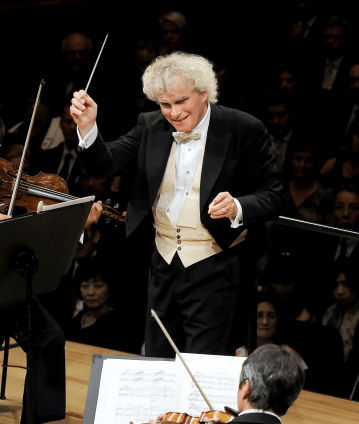Sir Simon Rattle with Sibelius, Ravel and Debussy at the Lucerne Festival

500 eager fans had to be turned away at the box office of the Lucerne Festival – such was the rush when the then chief conductor Simon Rattle decided on a bold programme for this guest performance by the Berliner Philharmoniker in Switzerland: Ligeti’s soaring Atmosphères flowed seamlessly into Wagner’s prelude to Lohengrin before the orchestra presented Sibelius’s Fourth Symphony. Jeux, a “poème dansé” (danced poem) by Debussy, and Ravel’s Daphnis et Chloé brought the concert to a light-footed conclusion.
Despite his exceptional status as Finland’s celebrated national composer, Jean Sibelius’s life was anything but carefree. He had been heavily in debt since his student days and suffered from a drinking problem that took its toll on his health: around 1910, he underwent several operations for suspected throat cancer. The year after, he finished work on his Fourth Symphony. Its harsh musical language pushes the boundaries of tonality, with particular emphasis on the use of tritones. The angular themes, abrupt endings and apparent incoherence of the structures may reflect Sibelius’s personal struggles during this period. The finale ends desolately in A minor – without any recognisable rhythm or melody. “To be human is miserable,” is how Sibelius quoted the Swedish writer August Strindberg in reference to his haunting and enigmatic Fourth.
An expression of steadily growing distress also pervades the opening work by György Ligeti. The premiere of Atmosphères in 1961 helped the composer to establish himself definitively in the field of contemporary music. This was the first time that the composer articulated his idea of “static music” in a work: completely detached from traditional forms, a continuously growing soundscape emerges, complex in its inner workings. Simon Rattle allows the piece to flow seamlessly into Richard Wagner’s prelude to Lohengrin. Its ethereal, transfigured radiance unfolds with all the more power and warmth when set in direct contrast.
Claude Debussy intensively examined Wagner’s long shadow. In his ballet music Jeux, small interval cells transform into ever-changing colours, creating an associative unity. Maurice Ravel’s Daphnis et Chloé is “an absolute masterpiece” for Sir Simon Rattle, “you could teach orchestration theory using this piece for at least ten years”.
© 2012 Accentus Music
Category
Artists
Our recommendations
- Europakonzert from Prague with Sir Simon Rattle and Magdalena Kožená
- The Berliner Philharmoniker, Simon Rattle and Karita Mattila at the “Proms”
- Mozart’s “Magic Flute” from Baden-Baden
- Simon Rattle with Bruckner’s Seventh in Taipei
- 2005 Europakonzert from Budapest with Simon Rattle and Leonidas Kavakos
- Karajan conducts Brahms’s “German Requiem” in Salzburg